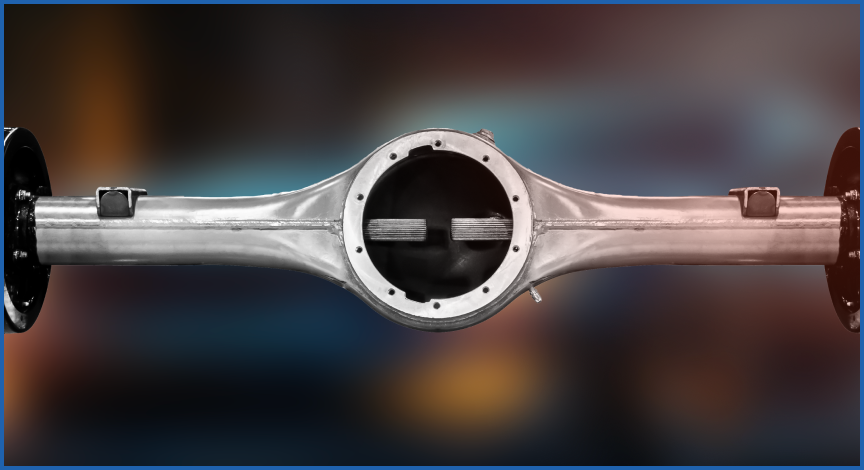Being a car enthusiast, you must have wondered how many axles your car has. Axles are the primary component in the movement of car wheels. They are the backbone of a vehicle and not only support the weight of the car, but also transfer power from the engine to the wheels and ensure a stable platform for steering. The manufacturers put great importance on the quality of the axle as it contributes to its overall performance.
What is the Axle on a Car?
In a four-wheel car, if you look at the front two wheels, the central steel road that connects them and acts as a bridge is called an axle. Without an axle, your wheel would not be able to rotate, and your vehicle would be stuck in one place.
Therefore, it plays a significant role when handling the car. It allows the wheel to rotate and provides support for the car’s weight. Moreover, it also assists in transferring power from the car’s engine to the wheels, which is crucial for moving the vehicle forward.
How Many Axles Does a Car Have?
Because one axle connects two wheels of the vehicle, a four-wheel car usually has two axles. These two axles are called the front and rear axles.
The front axle is located under the car’s front, and it transmits power from the engine to the front wheels.
The rear axle is located under the car’s rear and supports its weight. It transmits power from the engine to the rear wheels.
Larger wheels, such as those of buses, SUVs, and trucks, have more axles. The number of axles depends upon the vehicle’s weight, size, and usage.
How Does an Axle Work?
As you start a car, the engine shaft starts moving, giving the motor a rotational force. The engine’s crankshaft receives this rotational force and is further connected to the various components. This results in a drivetrain system, and the axle is one of the primary components connected to the crankshaft. The axle captures the rotational movement of the engine, transmitting power to the wheels.
Various mechanical parts are also involved in this connection. The axle receives the power and provides that power to the car’s wheels, which then move the car.
The axle plays a significant role in establishing the power transmission linkage from the engine to the wheels.
What is the Significance of an Axle?
Axles are crucial for a vehicle’s safety, performance, and reliability. In addition, they transmit power to the wheels. Below we discuss these points in detail.
Handle the Vehicle
When you push, accelerate, rotate the steering wheel, or apply brakes on the car, axles play their part in ensuring the balance of the car. They support the weight of the vehicle as the power of the wheels is divided into axles. They play a crucial role in ensuring smooth and reliable handling of the vehicle.
Synchronize in Wheel Movement
Because axles are connected to the wheel’s center and extend to the car’s differential, they enable smooth and synchronized wheel movement without wobbling.
Enhance the Performance of a Vehicle
The performance of your vehicle highly depends upon the quality of the axle. An axle of bad quality can affect the vehicle’s performance and destroy the wheel balancing and alignment. A good axle enhances the vehicle’s quality by improving the suspension and braking system, balancing the power, and reducing the risk of uneven tire wear.
What does a Two Axle, Three Axle, and a Four Axle Vehicle mean?
The number of axles defines how many wheels a car can support and how much weight it can carry,
- A two-axle vehicle has two axles, and a total of four wheels. Examples include small passenger cars and pickup trucks.
- A three-axle vehicle has three axles with six wheels in total. Examples include larger trucks, box trucks, and tractor-trailers.
- A four-axle vehicle has four axles with 8 wheels in total. This includes heavy-duty trucks for heavy loads, including construction equipment and large machinery.
Why Do Some Cars Have More Than 2 Axles?
The number of axles in a car depends upon their weight and intended use. Larger vehicles that carry more loads, such as buses and trucks, need additional axles to support the weight and dispense it across the wheels.
Extra axles provide stability and additional traction, making it easier to control the vehicle in different driving conditions.
For example, a vehicle that travels on rough tracks will need more axles to provide a better grip and prevent the vehicle from slipping or tipping over.
How Many Axles Does My Car Have?
Different cars are equipped with different axles depending upon the vehicle’s weight and features.
SUVs
SUVs have a rear axle setup that provides a balance between the weight of the vehicle and its stability. SUV cars usually have more than two axles.
Sedans
Sedans have a front axle setup installed. This is evident because the front axle is designed to offer a smooth and comfortable driving experience, which is why most sedans are equipped with it. People purchase sedans for comfort and fuel efficiency, and the front axle setup delivers that.
Truck
In trucks, a four-wheel drive axle setup or a rear axle type is installed. These types of axles assist in maintaining a smooth experience when a truck is moving with too much load on rough paths.
Electric Vehicles
We are living in the era of electric vehicles. These vehicles have an axle setup that is unique and different from other vehicles. This setup is called an E-axle that runs on electric power. It consists of a gearbox, an inverter, and a motor. Its size is much smaller than the conventional transmission engine, and it produces the same amount of power.
Off Road Vehicles
On off-road vehicles, a specialized axle setup is installed. Because these cars have to go through rough and bumpy roads, a specialized axle setup is installed to ensure safety, durability, and reliability.

